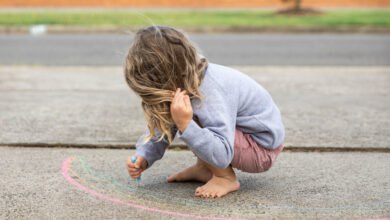I Tried It: A 30-Day Phone Breakup

[ad_1]
Years ago, while subletting an apartment in Germany, my boyfriend and I noticed something. Our host had good knives and leafy plants, but what stuck out most was the indigo cloth draped over every electronic, from the TV to the desktop computer. We didn’t even own a TV then and worked from laptops, but we soon saw the appeal of tucking any electronics out of sight.
Studies estimate we pick up our smartphones between 58 and 96 times a day; checking my iPhone’s Screen Time tracking feature is often horror inducing. If my phone is in my sightline, it’s irresistible. Most of the time, I’m not even aware of what I’ve been doing until I emerge from a fugue state 40 minutes later. Shoving my phone between the couch cushions actually helps. Otherwise, it’s hard not to check my email for the billionth time in case there’s some life-changing message waiting for me — even though it’s most likely just Gap offering me 40% off.
This spring, I felt exhausted by how much time I spent on my phone. So, I signed up for science journalist Catherine Price’s 30-Day Phone Breakup Challenge. For a month, Price texts you a short audio clip and specific challenge every day. (There’s also a book, if you’d prefer.) The goal isn’t to get rid of your phone but to develop a more intentional way of using it.
The first few days were easy enough. They involved getting a sense of when and why I used my phone. On Day Four, Price provided a phone background with three questions — “What for? Why now? What else?” — meant to be answered before unlocking a phone. I kept it as my lock screen until they became ingrained.
“You’d think the best way to get us to check our phones obsessively would be to make sure that there was always something good waiting for us,” Price explains in the first half of her book. “But what really gets us hooked isn’t consistency; it’s unpredictability. It’s knowing that something could happen — but not knowing when or if that something will occur.” That’s how slot machines work, Price points out. On Day Five, it was time to delete one of the “slot-machine apps,” which can include social media, games, or news apps. I reluctantly said goodbye to Instagram but could feel how much I craved that dopamine hit of checking, checking, checking.
On Day Seven, I woke up and, over breakfast, flipped through an issue of Artforum magazine instead of reading on my phone. It was pleasant. The following day, I ate a sandwich for lunch without my phone for company. I’m eating a sandwich, I thought, chewing. I’m eating a sandwich. I guess that’s what’s called being in the moment? On Day Twelve, my phone got lost. It wasn’t that I’d just had it, it was that I couldn’t remember where I’d been using it last because it had been a few hours. For me, that was a sign of progress…and also an indicator of how tethered to my phone I normally am.
Paying more attention to when, where, and how I used my phone made me realize I wasn’t just frequently distracted. Instead, by having my phone always on hand, I was preventing myself from sitting still with my thoughts. And yet, the moment every day when I’m experiencing reduced stimuli and mostly standing around, aka taking a shower, is one of the most pleasurable parts of my day.
But even when I recognized what there was to gain, reducing my phone time still wasn’t easy. Things got better, then worse. It took a few days after Price recommended using an alarm clock (instead of my phone’s alarm function) for me to fish one out of a drawer and buy batteries. “You don’t live here anymore,” I said aloud, carrying my phone out of the bedroom, which had been established as a phone-free zone. But, over the next week, I bargained with myself. I had a bad day, I deserve to scroll on my phone in bed. Or, My back hurts, so after physical therapy, I get to re-download Instagram and stare at it forever. I felt like the personification of that “cats can have a little salami as a treat” meme.
When my older brother heard what I was up to, he laughed. “Your brain has spent 20 years developing an addiction to your phone and you’re trying to break that in one month?” He has a cynical bent — “it was okay” is considered effusive praise when it comes from him — but I actually found his negativity helpful. Of course it’s hard to reset a relationship to something that’s designed to be impossible to put down.
One of the biggest lessons of the challenge was that willpower wasn’t enough to keep me off my phone, but enacting multiple barriers to make it both less appealing and less accessible did help. Day Twenty was the long awaited 24-hour no-phone period. I’d been dreading it since the start. Honestly, it took me a while to remember how to even turn my phone off (!!!), but once I did, I enjoyed myself. It was much easier to not check my phone when it was totally off instead of in another room. Hours later, I noticed that a feeling of calm had descended over me. I’m not usually feeling that way, so it was pretty easy to figure out what to attribute it to.
Coincidentally, on the last day of the challenge, author Jami Attenberg released an installment of her newsletter Craft Talk on the subject of cellphones. She describes reading an interview with another writer talking about cigarettes. “He said that when he was smoking he always felt like he had 20 best friends in his pocket,” she writes. “There was always a good time to be had, even if it would only last for a minute or two. You were never really alone if you had cigarettes. I think about this a lot now when I think about my relationship with my phone. The fact that I can always reach one of my actual living best friends when I have my phone in my pocket, which is perhaps why I carry it with me so much or fall asleep with it resting on my bedside table.”
It’s true, phones are fun and filled with my favorite people. But I just don’t want to spend so many hours of my life stuck on the stupid thing. I try to remember Price’s directive that “there’s nothing wrong with mindless distraction,” the problem is when that becomes the default. Not constantly checking my phone helped reduce that annoying habit of texting and talking at the same time or pulling out my phone without thinking at a restaurant while waiting for the check, even when I’m sitting across from someone I love hanging out with.
Post-challenge, I was pleased to see I really do use my phone less. Taking that extra beat to articulate what I’m doing before I unlock it helps prevent mindless scrolling. Periodically turning my phone off also makes a difference, though that would be harder if I had dependents or a boss that required me to be always available.
Now, when I get home, I leave my phone in my bag by the door instead of bringing it from room to room. And upon arriving at someone’s house for dinner, I’ve stopped taking out my phone after hanging up my coat, unless it’s to take a thousand pictures of a very cute one-year-old I know. I now also enjoy activities that before I used to run out of time for, like going for neighborhood walks or trying new recipes.
One night, a few weeks after the challenge ended, I got out of the subway at my stop and began walking home. The guy a few paces ahead of me took out his phone and started scrolling. I felt the urge to do the same, but resisted. Half a block later, he started cursing. Distracted by his phone, he’d walked right into a pile of vomit on the sidewalk. I haven’t entirely succeeded in keeping my phone out of my bedroom, and I’d like to further cut down the time I spend on it each week, but I did at least make it home that night with clean shoes.
Alex Ronan is a writer and investigative reporter from New York. Her work has been published by Elle, New York Magazine, Vogue, and The New York Times. She lives in Brooklyn and is on Instagram (now not as much) and Twitter (sometimes).
(Photo by Nina Zivkovic/Stocksy.)
[ad_2]
Source link







